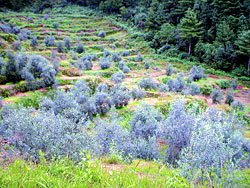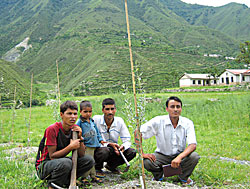|
|
It sounds like the whim of an eccentric Mediterranean magnate: ship 635 olive trees from Italy to plant in poor soil in the hills of a remote, 'food deficit' district in Nepal; but it's a project that the UN Food and Agriculture Organisation (FAO) takes seriously.
The two-foot saplings, of 28 imported and two local varieties, were planted in June on three hectares of land considered unproductive by local farmers
next to Kolti airfield. It's hoped that in about five years they will bear fruit, proving that European olives can survive in the far- and mid-west both as a cash crop and a source of healthy fat for villagers.
In late July and early August, the UN World Food Programme helicoptered more than 200 metric tonnes of emergency rice to Kolti to feed locals in eight nearby VDCs who must survive an annual 'food gap' between crops and who last year were additionally whacked by drought. The white, 40kg sacks of rice piled on the airfield were part of a larger WFP plan to feed 225,000 people living in 10 districts.
"Compared to an apple plantation, growing olives is very easy. It doesn't need much water or very fertile land. It's not plagued by insects or disease," says the FAO's BR Dhakal, manager of the million-dollar pilot project.
 Experiments grafting European olive species onto local wild olives-known here as launtho-are encouraging, and these trees could bear fruit within three years, adds Dhakal. Local olive trees grow in a handful of these districts and FAO, working with Tuscia University in Viterbo near Rome, has established another smaller plantation at a higher elevation in Dolpa.
Experiments grafting European olive species onto local wild olives-known here as launtho-are encouraging, and these trees could bear fruit within three years, adds Dhakal. Local olive trees grow in a handful of these districts and FAO, working with Tuscia University in Viterbo near Rome, has established another smaller plantation at a higher elevation in Dolpa.
Villagers use the olive trees mostly for fodder and firewood but the project aims to educate them in the benefits of consuming olive oil, the cornerstone of the celebrated 'Mediterranean diet'. And local managers of the Kolti
plantation have already calculated the potential value of their crop. A mature tree can produce 25kg of olives, which is processed into 5 litres of oil which can sell for more than Rs1,000 per litre, explains supervisor Janesh Bhandari.
In 2004-05, Nepal imported more than Rs 28,000,000 worth of olive oil, according to Dhakal.
This is not the first time that olives have been suggested as a niche crop for the country. More than two decades ago, an EU project imported and planted trees in Kirtipur, Jumla, and Marpha. Two are surviving in the Mustang village and bear fruit annually.
In the late 1990s, an Italian team planted other trees at Mugu's Rara Lake-five remain and are flowering now, according to Dhakal. But the best-known endeavour, one that continues today, is the private Himalayan Plantation near Kathmandu.
Olive Valley
 It was just over a decade ago that Hartmut Bauder's team strapped on dokos and carried 2,000 olive saplings, bamboo stakes and other materials weighing about 170 tonnes in total into the new Himalayan Plantation in Chitlang.
It was just over a decade ago that Hartmut Bauder's team strapped on dokos and carried 2,000 olive saplings, bamboo stakes and other materials weighing about 170 tonnes in total into the new Himalayan Plantation in Chitlang.
They then hand dug 2,000 holes for the Italian imports and when the monsoon hit and water filled some of the holes drowning about 100 trees, they opened the earth again, this time devising stone-lined drainage channels for each plant.
"Slowly we built up our knowledge-these are problems other olive-growing countries don't have," says Bauder, sitting on the terrace at his home in Taiba in Hatiban.
Ten years later, the plantation on the other side of the Kathmandu Valley via Thankot has doubled in size to 10 hectares and Bauder has added five new tree varieties from Provence to the original 15 he chose after seeing olives flourish in the hills of northern India.
His product has been tested in Australia, Germany, and Italy. "They all confirmed that we have excellent oil so Nepal has very good potential. That was quite satisfying but now we would like to have more oil-it costs a lot to run this company."
At a couple of hundred litres a year, production is too small to start large-scale export so Bauder sells mostly to people living in Nepal who hear about the oil by word-of-mouth. He has also started selling trees, along with training. One of his latest customers is the Shechen Monastery in Bouddha, which bought 500 saplings.
The monastery's Khenpo Gyurme says a friend from Hong Kong who bought oil from Bauder suggested the monks start growing olive trees. "We have space and we thought it would be good for the environment and maybe have a financial benefit also," he told us.
Gyurme visited Bauder's plantation a couple of times and then went to the grower's home to watch him press the olives. "I tasted the first oil from this year's crop. It was fruity and sort of sweet," he told us with a smile.
Soon after, Shechen planted 500 trees at its retreat in Kabre. According to Bauder, "it would be a very good idea if more monasteries decided on olives. That would be a sound basis for the development of this culture in Nepal."
In any case, he says he's satisfied with the slow growth of what began as an experiment. "It's not a question of 10 years, it's a question of 100-150 years-even for experts, and we're not experts." He's also resolute: "the more you know, the more you read and talk to experts, the more that everybody's convinced it's the ideal tree for Nepal."



